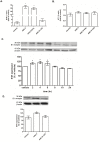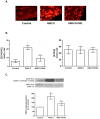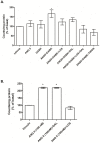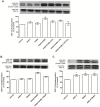An interaction of renin-angiotensin and kallikrein-kinin systems contributes to vascular hypertrophy in angiotensin II-induced hypertension: in vivo and in vitro studies
- PMID: 25369284
- PMCID: PMC4219703
- DOI: 10.1371/journal.pone.0111117
An interaction of renin-angiotensin and kallikrein-kinin systems contributes to vascular hypertrophy in angiotensin II-induced hypertension: in vivo and in vitro studies
Abstract
The kallikrein-kinin and renin-angiotensin systems interact at multiple levels. In the present study, we tested the hypothesis that the B1 kinin receptor (B1R) contributes to vascular hypertrophy in angiotensin II (ANG II)-induced hypertension, through a mechanism involving reactive oxygen species (ROS) generation and extracellular signal-regulated kinase (ERK1/2) activation. Male Wistar rats were infused with vehicle (control rats), 400 ng/Kg/min ANG II (ANG II rats) or 400 ng/Kg/min ANG II plus B1 receptor antagonist, 350 ng/Kg/min des-Arg(9)-Leu(8)-bradykinin (ANGII+DAL rats), via osmotic mini-pumps (14 days) or received ANG II plus losartan (10 mg/Kg, 14 days, gavage - ANG II+LOS rats). After 14 days, ANG II rats exhibited increased systolic arterial pressure [(mmHg) 184 ± 5.9 vs 115 ± 2.3], aortic hypertrophy; increased ROS generation [2-hydroxyethidium/dihydroethidium (EOH/DHE): 21.8 ± 2.7 vs 6.0 ± 1.8] and ERK1/2 phosphorylation (% of control: 218.3 ± 29.4 vs 100 ± 0.25]. B1R expression was increased in aortas from ANG II and ANG II+DAL rats than in aortas from the ANG II+LOS and control groups. B1R antagonism reduced aorta hypertrophy, prevented ROS generation (EOH/DHE: 9.17 ± 3.1) and ERK1/2 phosphorylation (137 ± 20.7%) in ANG II rats. Cultured aortic vascular smooth muscle cells (VSMC) stimulated with low concentrations (0.1 nM) of ANG II plus B1R agonist exhibited increased ROS generation, ERK1/2 phosphorylation, proliferating-cell nuclear antigen expression and [H3]leucine incorporation. At this concentration, neither ANG II nor the B1R agonist produced any effects when tested individually. The ANG II/B1R agonist synergism was inhibited by losartan (AT1 blocker, 10 µM), B1R antagonist (10 µM) and Tiron (superoxide anion scavenger, 10 mM). These data suggest that B1R activation contributes to ANG II-induced aortic hypertrophy. This is associated with activation of redox-regulated ERK1/2 pathway that controls aortic smooth muscle cells growth. Our findings highlight an important cross-talk between the DABK and ANG II in the vascular system and contribute to a better understanding of the mechanisms involved in vascular remodeling in hypertension.
Conflict of interest statement
Figures





References
-
- Shen B, El-Dahr SS (2006) Cross-talk of the renin-angiotensin and kallikrein-kinin systems. Biol Chem 387: 145–150. - PubMed
-
- Zhuo J, Moeller I, Jenkins T, Chai SY, Allen AM, et al. (1998) Mapping tissue angiotensin-converting enzyme and angiotensin AT1, AT2 and AT4 receptors. J Hypertens 16: 2027–2037. - PubMed
-
- Su EJ, Lombardi DM, Siegal J, Schwartz SM (1998) Angiotensin II induces vascular smooth muscle cell replication independent of blood pressure. Hypertension 31: 1331–1337. - PubMed
-
- Leeb-Lundberg LM, Marceau F, Muller-Esterl W, Pettibone DJ, Zuraw BL (2005) International union of pharmacology. XLV. Classification of the kinin receptor family: from molecular mechanisms to pathophysiological consequences. Pharmacol Rev 57: 27–77. - PubMed
Publication types
MeSH terms
Substances
LinkOut - more resources
Full Text Sources
Other Literature Sources
Medical
Research Materials
Miscellaneous

